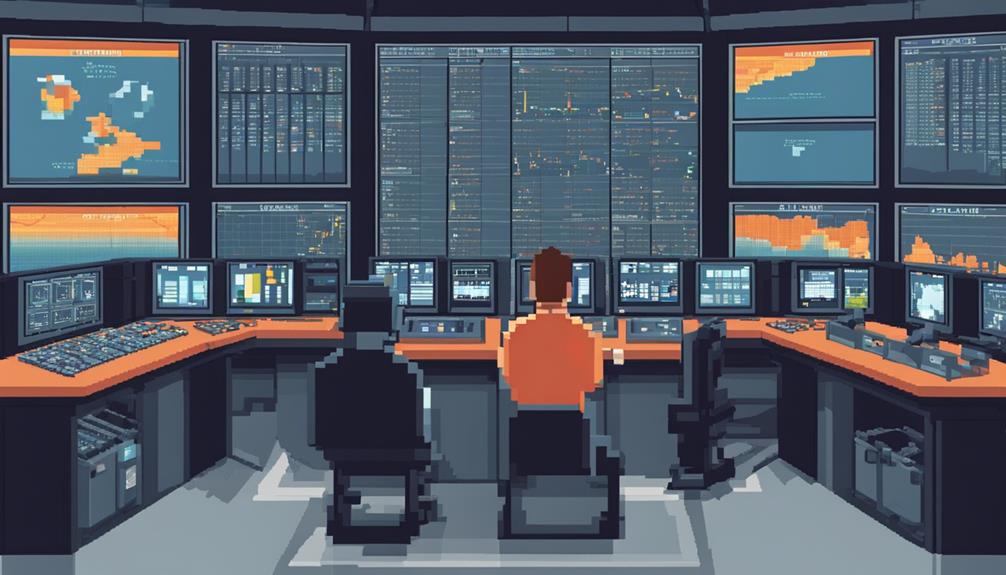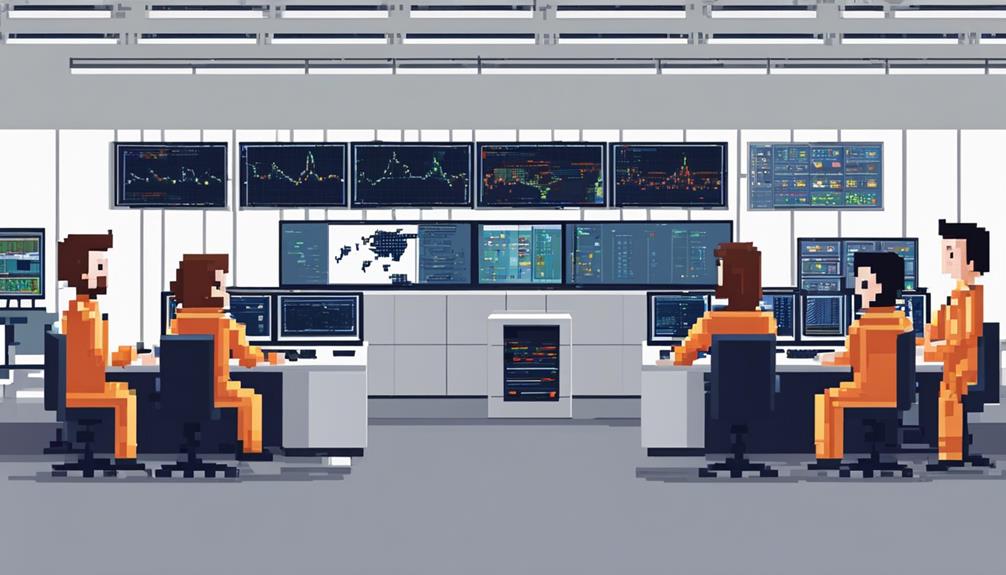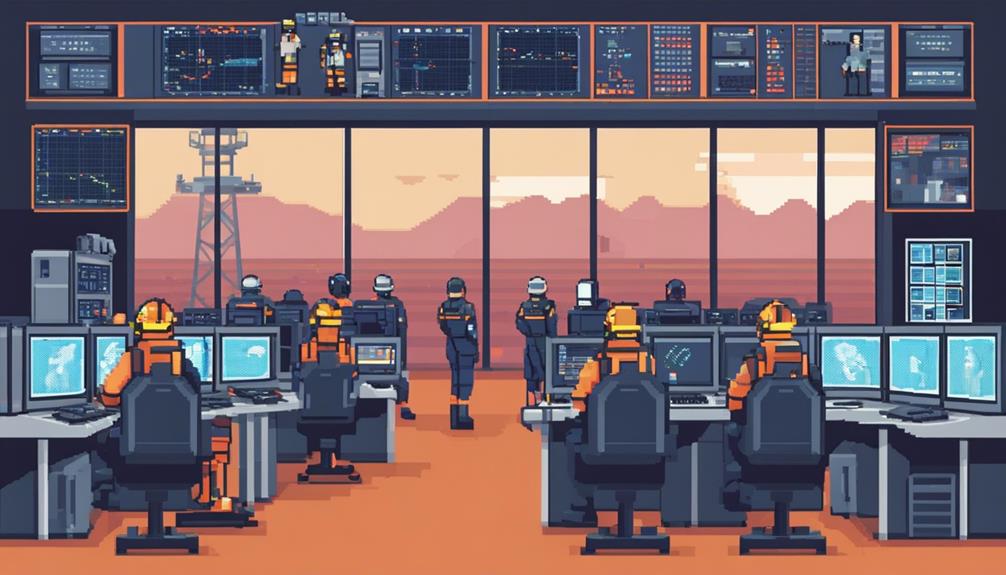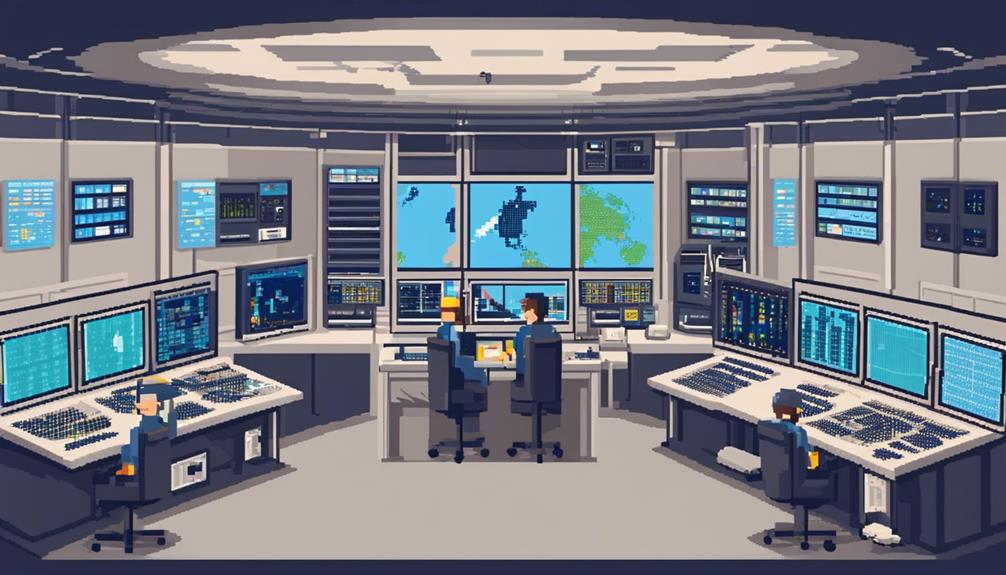Within the confines of SpaceX's Launch Control, a symphony of cutting-edge technology and unparalleled expertise orchestrates the intricate ballet of a rocket's journey into the cosmos. Imagine a room pulsating with silent intensity, where every beep and flicker on the monitors holds the weight of a mission's success or failure. As engineers meticulously navigate through complex algorithms and real-time data streams, the gravity of their responsibilities becomes palpable. Yet, behind the sleek consoles and glowing screens lies a world of protocols, analyses, and contingencies that shape the foundation of each launch. In this controlled chaos, the boundary between triumph and catastrophe is a razor's edge, where every decision weighs heavily in the balance of space exploration's future.
Key Takeaways
- Strategic layout and communication in the control room optimize mission execution.
- Real-time monitoring ensures precise analysis for anomaly detection and quick response.
- Safety protocols and emergency response procedures prioritize personnel and mission protection.
- Data analysis drives operational effectiveness, decision-making, and continuous improvement for successful launches.
The Control Room Setup

The Control Room at SpaceX, meticulously designed and equipped with 24 consoles manned by engineers wearing headsets, serves as the nerve center for monitoring rocket launches. This mission control hub is where critical decisions are made, and real-time data is analyzed to ensure the success of each mission. The layout of the control room is strategically organized to provide each engineer with access to the necessary tools and information to carry out their specific roles effectively.
Large screens adorn the walls of the control room, displaying live feeds of rocket launches. These screens allow engineers to closely monitor every aspect of the launch process, from liftoff to stage separation. The real-time visuals provide valuable insights into the performance of the rocket and help identify any anomalies that may arise during the mission.
Communication between engineers at the launch site and mission control is paramount for mission success. Engineers at the control room must maintain clear and constant communication with their counterparts on the ground to ensure that the mission progresses smoothly. This seamless coordination is essential for addressing any unforeseen challenges that may arise during the launch process.
Monitoring Launch Parameters
Engineers in the SpaceX mission control room meticulously track real-time data on critical launch parameters, including fuel levels, engine performance, and trajectory data. Advanced technology enables continuous monitoring of the rocket's status throughout the launch process, ensuring precise data analysis and decision-making. Communication between mission control and the launch site is vital for coordinating and adjusting the launch sequence as necessary.
Real-Time Data Analysis
Within the confines of SpaceX's mission control, a dedicated team meticulously scrutinizes real-time data analysis of launch parameters throughout rocket launches. Engineers analyze critical data points like velocity, altitude, trajectory, and engine performance. By closely tracking telemetry data, mission operators ensure the rocket follows the correct path and operates optimally. Real-time data analysis is crucial for promptly detecting any anomalies or issues during the launch process, allowing for immediate response. Monitoring launch parameters with precision is imperative for the success and safety of SpaceX missions.
| Launch Parameters | Data Analyzed | Importance |
|---|---|---|
| Velocity | Speed of the rocket | Ensures the rocket is on the correct trajectory |
| Altitude | Height of the rocket | Verifies the rocket's position relative to the desired path |
| Trajectory | Path of the rocket | Confirms the rocket is following the intended course |
| Engine Performance | Engine status and function | Ensures optimal propulsion and thrust capabilities |
Critical System Alerts
Amidst the intense environment of SpaceX's launch control, critical system alerts diligently monitor key launch parameters essential for mission success and safety. Engineers at mission control closely monitor fuel levels, engine performance, and trajectory data of the Crew Dragon spacecraft. Immediate notifications are sent out on any anomalies or deviations from the pre-defined launch criteria. These alerts are crucial in ensuring the safety and success of the rocket launch by enabling a rapid response to any unexpected issues. Mission operators rely on advanced monitoring systems to track the real-time status of the rocket and make informed decisions based on the alerts received. The swift identification and resolution of critical system alerts underscore SpaceX's dedication to operational excellence and mission success.
Launch Trajectory Tracking
Launch Trajectory Tracking plays a pivotal role in ensuring the precise execution of SpaceX rocket missions by meticulously monitoring key parameters essential for mission success and safety. Engineers at mission control closely track the rocket's trajectory, including speed, altitude, and position, in real-time. Through the analysis of telemetry data, they verify the rocket's adherence to the planned path and its expected functionality throughout the flight. This system enables real-time adjustments to the rocket's trajectory if needed to meet mission objectives. The accuracy of trajectory tracking is paramount for ensuring the safety of the mission, payload, and potentially crew onboard the spacecraft. Mission control's vigilance in monitoring these parameters contributes significantly to the overall success of the mission.
Communication Systems in Place
Engineers at SpaceX's mission control utilize headsets connected to 24 individual consoles to facilitate real-time communication during rocket launches. These headsets ensure that key information is relayed efficiently and accurately between team members. Additionally, large screens in the control room provide live feeds of rocket launches, aiding in monitoring and analysis for mission success.
Key Communication Equipment
The communication systems at SpaceX's mission control incorporate advanced headsets and real-time monitoring displays to ensure seamless coordination during rocket launches. Engineers at 24 different consoles use these advanced headsets for precise communication. Large screens in the mission control room provide real-time live feeds of rocket launches, enabling engineers to monitor and analyze the progress effectively. Communication between the launch site and mission control is vital for the success of SpaceX's missions, with mission operators using cutting-edge technology to monitor various stages of the launches. The mission control room at SpaceX is meticulously designed to create a quiet, warm, and modern environment conducive to effective communication and coordination during rocket launches.
Team Coordination Strategies
With a sophisticated network of communication systems in place, SpaceX's mission control center employs strategic team coordination strategies to ensure seamless operations during rocket launches. Engineers utilize headsets at 24 different consoles to communicate effectively and efficiently. Communication between the engineers at the launch site and mission control is paramount for the success of missions, especially when sending astronauts to the International Space Station. Mission operators undergo rigorous training to guarantee smooth and clear communication channels. Real-time monitoring of rocket launch stages using advanced technology aids in precise coordination among team members. The mission control room at SpaceX is designed to be a quiet, warm environment with a modern aesthetic, fostering efficient communication and collaboration among team members.
Safety Protocols During Launch

Ensuring the integrity of critical valves is paramount in SpaceX's safety protocols during rocket launches. SpaceX implements rigorous pre-launch inspections of all valves on the Crew Dragon and Cargo Dragon spacecraft to guarantee optimal performance. These safety measures are crucial in preventing any potential valve corrosion issues that could jeopardize the success of the mission. Engineers at SpaceX mission control meticulously monitor the status of all valves during the launch countdown, ensuring that all systems are functioning correctly to maintain a safe environment for the crew and payload.
To emphasize the importance of safety protocols during launch, consider the following emotional impact table:
| Safety Measure | Importance Level |
|---|---|
| Pre-launch valve inspections | High |
| Monitoring valve status | Critical |
| Crew safety checks | Top Priority |
| Commitment to safety protocols | Dedication |
This table illustrates the meticulous attention to detail and the high priority placed on safety within SpaceX's launch control operations. The focus on valve integrity and crew safety showcases SpaceX's unwavering commitment to ensuring the success of every mission.
Role of Launch Directors
In the realm of SpaceX's launch operations, the pivotal figure of the launch directors orchestrates and oversees all facets of the launch process, from pre-launch preparations to mission execution. SpaceX launch directors hold the crucial responsibility of making decisive judgments during the countdown phase and ensuring the safety and success of the mission. Working in close collaboration with mission control teams and engineers, SpaceX launch directors are tasked with addressing any potential issues or anomalies that may arise before or during the launch. Their primary focus lies in upholding seamless communication and coordination among diverse teams involved in the launch operation.
The expertise and experience of SpaceX launch directors are paramount in the overall success of the company's rocket launches. They are instrumental in guiding the launch process, monitoring critical parameters, and taking prompt actions when necessary to guarantee a smooth and efficient mission. By liaising with various stakeholders and leveraging their in-depth understanding of the launch procedures, SpaceX launch directors play a vital role in navigating the complexities of space missions. Their leadership and oversight within the mission control center are fundamental to the achievement of SpaceX's ambitious goals in space exploration.
Data Analysis and Interpretation

Engineers at SpaceX mission control employ sophisticated data analysis tools to meticulously monitor real-time data during rocket launches. Data analysis is a critical component of mission control operations, enabling engineers to interpret vast amounts of information quickly and accurately. By analyzing data from various sensors and cameras in real-time, mission operators can make informed decisions to ensure the success and safety of SpaceX missions. The ability to interpret data rapidly allows for timely responses to any anomalies or issues that may arise during the launch process.
Mission control relies on advanced data analytics to assess the performance of the rocket, monitor environmental conditions, and track the status of critical systems. This data-driven approach provides valuable insights that guide decision-making throughout the launch sequence. The accuracy and speed of data analysis at SpaceX mission control are essential for maintaining the efficiency and effectiveness of rocket launch operations. By leveraging data analysis tools, engineers can identify trends, anomalies, and potential risks, allowing them to adjust course as needed to achieve mission objectives. In conclusion, data analysis is a cornerstone of SpaceX's mission control operations, enabling engineers to ensure the success of each rocket launch.
Countdown Sequence Overview
At SpaceX's Launch Control, the countdown sequence meticulously coordinates pre-launch procedures to ensure the systematic readiness of critical systems and components for liftoff. Engineers and operators at mission control follow a specific timeline leading up to the launch of Falcon 9 rockets. The countdown sequence is a crucial phase where all systems are thoroughly checked and monitored to guarantee optimal performance during liftoff.
During the countdown, every second is meticulously planned and executed to ensure the safety and success of the mission. SpaceX's Launch Control maintains constant communication with the rocket and crew, providing real-time updates and alerts as needed. The countdown sequence is not just a series of steps but a synchronized ballet of operations where precision is paramount.
Below is a table outlining some key aspects of the countdown sequence overview at SpaceX's Launch Control:
| Aspect | Description | Importance |
|---|---|---|
| Pre-launch checks | Verification of critical systems and components to ensure they are functioning correctly | Ensures safety |
| Communication protocols | Clear and constant communication between mission control, the rocket, and crew | Vital for coordination |
| System monitoring | Continuous monitoring of systems and components to detect any anomalies or issues | Ensures mission success |
Emergency Response Procedures

The stringent emergency response procedures at SpaceX's Launch Control are meticulously designed to safeguard personnel and mission objectives in critical situations. Within the mission control facility, operators are trained to handle various emergency scenarios with precision and efficiency. These scenarios are not only planned but also simulated to ensure that mission control teams are well-prepared to respond quickly and effectively in times of crisis.
Communication protocols play a vital role in coordinating emergency actions between Launch Control and on-site teams. Clear lines of communication are established to facilitate seamless coordination and decision-making during emergencies. Redundant systems and backup options are in place to mitigate risks and address emergencies promptly should unexpected issues arise during critical phases of the launch.
To maintain readiness, regular drills and training sessions are conducted for Launch Control personnel. These exercises are essential for keeping the team sharp and prepared to handle any emergency situation that may arise. By prioritizing preparedness and practicing responses to potential crises, SpaceX's Launch Control ensures a high level of safety and security for both personnel and mission objectives during all phases of the launch process.
Post-Launch Data Review
Following the successful launch of a rocket and spacecraft, an in-depth post-launch data review is meticulously conducted at SpaceX's launch control facility. Engineers delve into the telemetry data, sensor readings, and video footage to gain a comprehensive understanding of the mission's performance. This critical analysis serves multiple purposes, from evaluating the success of the launch to extracting valuable insights for future missions. Key aspects of the post-launch data review include:
- Performance Evaluation: Engineers meticulously scrutinize the data to assess how well the rocket and spacecraft systems performed during the mission. By comparing the actual data with expected values, they can pinpoint areas of improvement and potential optimization for upcoming launches.
- Anomaly Detection: The review process aims to identify any anomalies or issues that arose during the mission. Detecting and understanding these deviations from the norm is crucial for enhancing the reliability and safety of future missions.
- Mission Success Assessment: Through the post-launch data review, SpaceX engineers can gauge the overall success of the mission in meeting its objectives. This assessment plays a vital role in informing NASA and other stakeholders about the mission's outcomes and the effectiveness of SpaceX's mission operations.
Frequently Asked Questions
Where Is Spacex Control Room?
The SpaceX control room, pivotal in overseeing launch procedures, is situated at the SpaceX headquarters in Hawthorne, California. This technologically advanced hub is equipped with 24 consoles featuring large screens displaying live rocket launch feeds. Mission operators, utilizing headsets, closely monitor all stages of rocket launches in real-time from this centralized location. Effective communication between the engineers at the launch site and mission control within the SpaceX control room is fundamental for the success of missions.
Does Spacex Need Permission to Launch Rockets?
For each commercial space launch in the United States, SpaceX must adhere to regulatory requirements set by the Federal Aviation Administration (FAA) to obtain launch authorizations. The FAA evaluates factors such as public safety, national security, and environmental impact before granting SpaceX permission to proceed with a rocket launch. Collaboration between SpaceX and the FAA ensures compliance with regulations, emphasizing safety and legal obligations throughout the launch process.
Why Did Starship Explode Today?
The Starship explosion today occurred during a planned test, prompting an investigation update to determine the root cause. SpaceX conducts these tests to enhance the Starship's design and safety features. Through meticulous analysis and a comprehensive root cause analysis, SpaceX aims to gather crucial data that will aid in refining the spacecraft's capabilities. This incident will provide valuable insights for future improvements, ensuring the reliability and safety of the Starship spacecraft.
What Went Wrong With Starship?
The Starship encountered a launch vehicle failure due to anomalies in the Starship design and engineering. Issues with the Raptor engines, heat shield tiles, and landing procedures contributed to the malfunction. SpaceX has made design changes and improvements to address these challenges. Despite setbacks, the company continues to iterate and test Starship prototypes to advance the technology for future deep space exploration missions.
